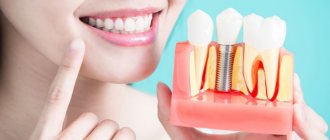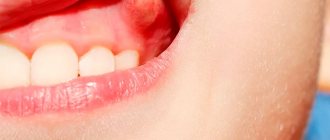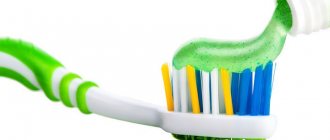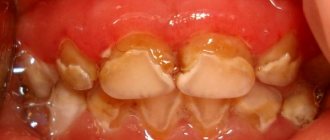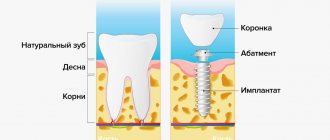Discoloration of gums is a fairly common problem with which patients often seek help from a dentist. The seriousness of this disease lies in the fact that the blue color of the gums can indicate not only some dental disease, but also the presence of severe somatic pathologies. Diagnosing the disease at an early stage and promptly starting treatment is the key to quickly getting rid of the disease without developing any complications.
If the filling interferes after treatment
Even in the doctor’s office, after installing the filling, be sure to make sure that the restored tooth is not in the way (move your jaw back and forth, sideways, carefully close your teeth). The filling should not be felt or change the bite. Don’t be shy about talking to your doctor about any discomfort—sometimes the final stage of filling treatment can take even longer than removing cavities and applying filling material.
After treatment, anesthesia wears off within 1.5-2 hours. If a conductor type was used, then after 4-6 hours. Now you are beginning to fully feel the treated tooth, you can fully close your jaws and understand how comfortable you are after filling.
If you experience slight discomfort, it feels like the tooth is a little larger and your jaws aren't closing quite tightly—this is normal. The fact is that now you have been given a new filling in accordance with the bite, that is, with the shape and position of the tooth located on the opposite side. The treated tooth became taller than before - after all, there was caries and the old filling sagged. Therefore, if there is no sharp pain and obvious rejection, be patient for a few days. If the situation normalizes and you get used to it, then there is no reason to see a doctor. If discomfort persists for 1-2 weeks, you should visit your dentist to have the filling corrected.
Laser treatment
Laser excision of the hood provides better results. The main advantages include:
- lower risk of inflammatory complications, including secondary wound infection;
- coagulating effect of the laser - no risk of bleeding;
- short recovery period;
- reduction of pain after intervention;
- no need to additionally treat intervention areas with turundas and antiseptics.
There are few contraindications for laser intervention, one of them being cancer.
How long should you not eat after having a filling installed?
If a filling made of chemical composites is installed, then you should refrain from eating and drinking for 2 hours. This is due to the fact that the material requires a certain time for final shrinkage and hardening.
If a “light” composite filling is installed, you can drink immediately, but you should abstain from food for 1.5-2 hours. But the reason is not in the material (it hardens a few seconds after application), but in anesthesia - with reduced sensitivity of the mucous membranes during eating, you can injure the tongue and mucous membranes of the cheeks on the inside.
During the day after the filling is installed, you should only eat warm foods - excessively hot or cold foods can lead to changes in the shape of the filling. It is necessary to chew food on the opposite side for the first day - this will allow the material to fully “adhere” to the tissues and take the desired shape, without the risk of damage.
Bleeding gums when brushing teeth
Sometimes blood spots on the brush are perceived as a sign of inflammation, but this is not always the case. Often, the reason is trivial - incorrectly selected bristles or too zealous hygiene. To reduce the risk of injury, dentists remind you of the rules for brushing your teeth:
- Movements of the bristles along the vestibular side should not be from side to side, but up and down, as if sweeping away remnants of food and plaque.
- Medium hardness is optimal, but if you have pathological sensitivity, it is better to buy soft ones (Soft) and even ultra-soft ones (Ultra Soft).
- If the brush is positioned slightly at an angle to the teeth, the chance of better cleaning of gaps increases.
- It is advisable to move along the gum line in a circular motion - additional massage stimulates blood circulation.
- You should spend 40 seconds to a minute cleaning your tongue. Much more bacteria accumulates on its surface than on enamel, but many people ignore this fact.
- If you have an irrigator at home, it is recommended to put periodontal attachments on it at least once a week and clean out the gum pockets. Make sure that the water supply is turned on at minimum power at this moment, otherwise there is a risk of tissue rupture.
- For those who wear braces and other devices, it is better not to skimp on special brushes. A large amount of plaque accumulates under the ligatures and the corrective arch, which must be removed daily.
- It is necessary to change the brush every 2 months, and if you are prone to inflammation - monthly.
Why does a tooth hurt after a filling is installed?
Minor soreness may persist for several days or even a couple of weeks, which is explained by overheating of the tissue due to the use of boron. In some situations, for example, with deep caries or when treating front teeth, increased sensitivity can persist even for several months. But in such a situation, you should still consult a doctor for an x-ray to make sure that there is no infected tissue left under the filling and that inflammation has not affected the nerve.
If the pain intensifies, the filling darkens, black spots appear under it - all this indicates that the treatment was carried out poorly and re-inflammation has begun. This is a reason to see a doctor as soon as possible.
When to see a doctor
There are situations in which it becomes impossible to visit your doctor. In such cases, you should remember about the serious causes of blue gums that require urgent treatment:
- cyanosis does not subside within 4–5 days;
- in addition to changes in gum color, there are signs of local inflammation (hyperemia, swelling of soft tissues, bleeding gums);
- I am concerned about acute pain that is not relieved by painkillers;
- a sharp increase in body temperature to 38–39 degrees;
- deterioration of the general condition of the body, weakness.
Ignoring a dental problem is fraught with the development of serious consequences. Severe complications include: the formation of a benign or malignant tumor, as well as the occurrence of an intraoral cyst.
What to do if your gums hurt after filling
The gums in the area where the anesthesia was administered may ache for several days - this is completely normal and does not require any measures. The mucous membrane may also be slightly inflamed if special rings were used during treatment, which are placed on the tooth to form the correct shape of its crown. The gums can also be damaged if the doctor had to install the filling material in close proximity to the mucous membrane or even under it - in such a situation the gums are deliberately pushed back. Therefore, pain is a normal reaction to external intervention.
All of these conditions are variations of the norm. But if the pain intensifies, redness and swelling of the mucous membrane progresses, you need to consult a doctor.
Why do my gums turn blue?
There are many factors that influence periodontal health. The incidence rate depends on both the age of the patient and his dental status.
Causes of blue gums in a child
Blueness of soft tissues in a child’s mouth can occur for the following reasons:
- Eruption of primary and permanent or permanent teeth.
Due to high mechanical pressure on the blood vessels of the periodontium, a blue hematoma occurs.
- Bruises and cuts.
After falls during active games, multiple hematomas occur. Due to mechanical trauma, a blood clot accumulates at the site of the bruise, as a result of which the gums around the tooth become blue.
Why does an adult's gums turn blue?
The causes of blue gums in an adult can be:
- Disorders of the cardiovascular system, endocrine system, and kidney disease.
- Inflammatory diseases of the oral cavity: gingivitis, periodontitis, herpetic and candidal stomatitis, periodontal disease, accompanied by the deposition of bacterial plaque on the surface of the teeth.
- Caries and its maltings, localized in the cervical area of the tooth.
- Errors in orthodontic treatment.
An incorrectly made denture impairs blood flow in the gingival margin, causing the appearance of a blue tumor. In this case, blue discoloration is a consequence of a violation of the trophism of soft tissues in the oral cavity.
- Surgery.
Blue gum most often occurs after tooth extraction. As a rule, tightening of soft tissues is completed by 10 days after extraction.
- Burns from chemical and thermal irritants.
Chemical burns occur due to exposure of the mucous tissue to aggressive substances used in endodontic treatment. Blue injuries from exposure to high temperatures occur at the household level.
How to properly perform hygiene procedures
After treatment, brush the filled tooth carefully, applying minimal pressure to it. Do not use rinses containing abrasive substances and alcohol, which can increase the plasticity of the material - this will lead to a change in the shape of the filling. Also, do not use excessively hard brushes - they can leave microcracks in the material, which will quickly damage it.
In general, you should take care of teeth with fillings in a completely standard way:
- daily brushing of teeth twice a day - in the morning before breakfast and in the evening after all meals, after - rinsing the mouth with water and rinse,
- To clean the area of filled teeth after eating, it is better to replace dental floss with an irrigator. If you floss carelessly, you can touch the installed filling, especially if there are thin edges of the tooth, which will lead to its loss.
Causes of weak gums
If you carefully study every case of visiting a dentist about weak and loose gums, then almost always the patient has either plaque or tartar. It is these conditions that lead to the appearance of such a problem. Failure to comply with oral hygiene rules leads to the accumulation of microorganisms on soft and hard tissues. They, in turn, produce toxins that are harmful to mucosal cells. The situation can be aggravated if the following problems exist:
- Bite abnormalities.
- Caries.
- Vitamin deficiency.
- Diseases of some organs.
- Weakening the body's defenses.
Patients with these conditions should pay maximum attention to their health, regularly visit specialized specialists and take care of their body.
Is it necessary to follow a diet after caries treatment?
From the diet as a whole after caries treatment (especially if a large filling is installed and your own tooth has very thin walls), it is recommended to remove too hard foods - toffees, chewing gum, grilled fruit, nuts, etc. Or chew them with teeth located on the opposite side (if they do not have fillings).
Minimize the amount of consumed foods and drinks that contain coloring pigments (tea, coffee, beets) - under their influence, the filling material may slightly change its shade. This rule is especially relevant when restoring front teeth.
Resorcinol-formalin method of dental treatment
In 1912, a German dentist from Frankfurt am Main, Julius Albrecht, proposed resorcinol-formalin paste for the treatment of complicated caries.
The composition of the treatment mixture included only two components: resorcinol and formalin. The resorcinol-formalin method is not a pathology, but is an outdated method of dental treatment with a “lot” of side effects. In the same Germany, the progenitor of the method, the material Resorcinol was discontinued more than 50 years ago.
The method is based on the bactericidal and mummifying properties of this mixture, due to which the decay of the incompletely removed pulp on which this mixture is applied is stopped. The mixture slowly hardens in the tooth canals, which was thought to seal them.
Clogging the dental canals, this mixture hardened and became glassy. The method turned out to be cheap, easy to use and became widespread due to the fact that it did not require special skills from specialists. But after some time, the tooth treated in this way acquired a reddish tint, became fragile and often caused problems for the patient. That is why it was and is necessary in the vast majority of cases to re-treat the resorbed tooth. In fact, it turned out to be a poor and short-lived therapeutic solution.
How to maintain your treatment guarantee
As a rule, therapeutic treatment, that is, dental filling, is guaranteed from 6 months to 2 years - depending on the volume of work and the complexity of the situation. To maintain the guarantee, the patient must strictly follow all recommendations: do not overload the tooth, do not use it for other purposes (for example, open beer bottles), and also regularly see the doctor in accordance with the individual schedule of medical examinations. Unfortunately, many patients forget about this, and it is the last point that is the key to maintaining the guarantee for treatment.
You need to visit a doctor 1-2 times a year. During a preventive examination, the dentist will be able to make sure that the filling is in good condition and that caries does not develop again underneath it.
Strengthening gums: methods
In order for measures to strengthen the gums to give a positive result, it is necessary to eliminate the main causes of this problem: plaque, tartar and the accumulation of microorganisms in the oral cavity. To do this, you need to have your teeth professionally cleaned by a dentist, as well as regularly monitor your oral hygiene. As soon as the source of the problem disappears, you can move on to methods of strengthening the gums:
- Local anti-inflammatory therapy. Includes rinsing the mouth with antiseptic solutions and applying antimicrobial gels.
- Elimination of foci of possible infection (carious and non-carious lesions of teeth).
These treatment measures are carried out in a dental office. Some manipulations can be carried out at home, but it must be remembered that the immediate source of the problem must first be eliminated. If you start treatment without first removing plaque and tartar, the improvement will be temporary, and gum weakness will return as soon as the patient stops using these methods.
